- Qualcomm Launches Snapdragon 4 Gen 2 Mobile Platform
- AMD Launches Ryzen PRO 7000 Series Mobile & Desktop Platform
- Intel Launches Sleek Single-Slot Arc Pro A60 Workstation Graphics Card
- NVIDIA Announces Latest Ada Lovelace Additions: GeForce RTX 4060 Ti & RTX 4060
- Maxon Redshift With AMD Radeon GPU Rendering Support Now Available
Tech News
Beyond Good & Evil II
I knew this day would come. At Ubidays 2008 Ubisoft announced that they will in fact, be releasing Beyond Good & Evil 2. Beyond Good & Evil is easily one of the most underrated, underappreciated games in history. If you see it in the bargain bin, buy it, you’ll agree.
Ok so I didn’t need to see where that fly ended up, but I’m so thrilled we’re getting a second chance to hang out with Jade and friends. This game is going to be amazing and I’m doing my best not to just scream like a giddy schoolgirl.
Splashtop Coming to ASUS Notebooks in June
ASUS first acknowledged their plans to support DeviceVM’s Splashtop technology late last year, as we mentioned in our recent article, by supporting it on the company’s P5E3 Deluxe motherboard. Recently, however, ASUS sent out a press release saying they would provide their Express Gate software on all of their motherboards. We’ve seen the technology on some of their other boards since then, but we haven’t heard much of introducing the technology to notebooks, until now.
Favored by ASUS primarily for its low-energy usage and fast boot time, one can easily see why Splashtop remains appealing to mobile users. Being able to access a desktop interface to find files, surf the web, or chat online is a major attraction considering the fraction of the power drawn compared to using a full operating system and the near-instantaneous boot time.
The first Express Gate enabled notebooks will be the M70T, M50V and M51T multimedia series, as well as the F8Va/Vr series, which will ship in June of this year. If the past is any indication, I would expect more models to follow in the future.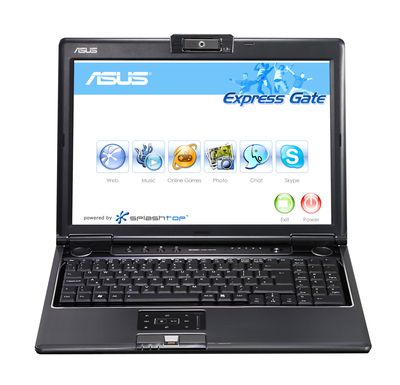
DeviceVM today announced the release of their award winning Splashtop™ software on numerous ASUS notebooks. Splashtop is a light-weight operating system that allows consumers to use their computers seconds after hitting the power button. Models spanning a wide range of segments are to ship with Splashtop pre-installed by ASUS starting in June this year.
“The integration of Splashtop into notebooks represents a big step forward in portable computing, where instant ‘on’ and ‘off’ is essential,” said Mark Lee, co-founder and CEO of DeviceVM. “We are pleased to introduce Splashtop to portable computing together with our partner ASUS.”
Branded “Express Gate” by ASUS, Splashtop software enables users to browse the web, watch videos, listen to music, chat with friends, share photos, and more – just seconds after turning on their PC. Express Gate is already available on a wide range of PC motherboards from ASUS. The notebooks announced today are the first to integrate Express Gate for the broad consumer market, including the M70T, M50V and M51T multimedia series and the stylish F8Va/Vr series.
Apple Releases Updates: 10.5.3, iPhone SDK Beta 6, and More
Today, Apple released its long-awaited 10.5.3 update to their Leopard operating system. Weighing in a 420MB, this update includes fixes for .Mac, Address Book, AirPort, Automator, iCal, iChat, Back To My Mac, Mail, Time Machine, Time Capsole, and many more. Updates to Logic Express and RAW compatibility for iPhoto ’08 and Aperture 2 were pushed as well to the appropriate users.
I ran the update on my MacBook, and had to reboot twice. I was fortunate enough not to have any nagging issues from 10.5.2, so I can’t personally comment on fixed bugs, but I haven’t run into any compatibility issues. Some users are reporting issues with SIMBL plug-ins (as with some previous updates), but there is a fix for the problem. If (and only if) you own an iPhone or an iPod touch, a new feature in Address Book allows you to sync Gmail contacts with your iPhone, as it already does with .Mac and Yahoo! contacts.
The company also released a new version of the iPhone SDK, but no information partarning to the update was included. Presumably, this will be the last verison of the "beta" iPhone SDK before Apple’s World Wide Developer Conference (WWDC), beginning June 9. The new SDK is tied to 10.5.3, so there is likely some code linking the two, which could be a technical reason or a clue to a new feature that has yet to be announced.

Apple released the Mac OS X 10.5.3 update today. The latest update to Leopard should appear in your Mac OS X Software Update.
The 10.5.3 Update is recommended for all users running Mac OS X Leopard and includes general operating system fixes that enhance the stability, compatibility and security of your Mac.
Besides releasing Mac OS X 10.5.3 today, Apple also released a new version of the iPhone SDK (Beta 6). No details have been posted. Apple should be wrapping up development of the iPhone SDK which is expected to be complete by late June. Apple will be covering many aspects of the iPhone SDK during their Worldwide Development Conference which starts on June 9th.
DS now stands for Digital Sketchbook
If you’re like me and haven’t touched your Nintendo DS in ages, or you have several because they come in so many colors, you can now turn your DS into a Digital Sketchbook! Jason Dunn at jasonrdunn.com has some examples of what is possible on the DS, provided you actually have the talent up front.

Here is an excerpt from the instructions:
The lower screen is used as the painting surface, while the upper screen displays the image at normal size. You paint with the stylus, but you can use just about anything as a brush. A full-size Wacom stylus works just fine on it. The color picker and brush settings are revealed with the L1 key, and you can choose a hard or soft brush and adjust the pressure and size settings. You can also assign pressure input to size and/or opacity of the brush.
Beware however, there is no UNDO, but there’s also no undo with real paint, so real artists will have no issue with this. However those of us who are lucky to be able to draw the turtle from the art school test, may find this more challenging.
You can find complete instructions and software downloads at Wired.com
Adobe Releases Initial CS4 Betas: Dreamweaver, Fireworks and Soundbooth
It’s hard to believe that Adobe’s CS3 suite has been out for well over a year, but it has. What’s that mean? CS4 has to be right around the corner. As is usual these days, Adobe has released three brand-new betas for upcoming CS4 software, including Dreamweaver, Fireworks and Soundbooth. Interestingly, Photoshop is not yet available, but being their pride and joy, it’s no surprise.
The only application I use of the three on a regular basis is Dreamweaver, and I gave the latest version a quick go. The biggest difference you’ll notice right off the bat is the much cleaner interface, and I’m already a big fan. CS3 wasn’t great-looking with Vista, but CS4 changes that entirely. Also new is a Live View that allows you to view your pages in real-world conditions, an improved code navigator, a CSS inspector, much improved Photoshop integration and more.
On the Fireworks side, it also has been treated to a new UI, but also includes the ability to create entire webpages in the application then export in a CSS standard layout for further editing in Dreamweaver, PDF export and AIR authoring. Not too much information is given about what’s new with Soundbooth, nor would I notice the difference if I looked, but music authors may want to have a look.
All the betas are free and run alongside your current installations. Check them out at Adobe Labs.
 |
Adobe Systems Incorporated (Nasdaq:ADBE) today gave a sneak peek at three applications from the next release of Adobe Creative Suite, its award-winning collection of graphic design, Web development and video editing applications. The company released public beta of new versions of Adobe Dreamweaver, Adobe Fireworks and Adobe Soundbooth as free downloads on Adobe labs.
Bigger is Not Better, Says AMD
In the tech world, bigger is better, right? Wrong, according to AMD. When asked by a C|Net blog as to why they are not building huge chips like NVIDIA, they responded, “We believe this is [building smaller chips] is a much stronger strategy than going for a huge, monolithic chip that is very expensive and eats a lot of power and really can only be used for a small portion of the market.“
Tu shay, AMD, tu shay. That’s a valid point, though. Why build a massive power-sucking processor rather than pairing two efficient processors together for the same performance? It can be argued though, that this is a needless argument, because the fact of the matter is, dual-GPU cards are still watt-suckers. This will always be the case unless the architecture is redesigned to allow one GPU to be shut off while it’s not needed.
The other argument that can be brought up is that one massive GPU is better than two mid-range offerings, because it will increase performance in all games, not only those that can properly take advantage of a multi-GPU setup. One GPU would deliver the full load of power, while a multi-GPU card may only deliver one-half of its available power. It all varies from game to game, however, and many today will indeed handle multi-GPU setups well.
One things for sure though, with AMD’s next-gen dual-GPU offering and NVIDIA’s massive single-GPU card en route, next month is going to be incredibly interesting.

|
“We believe this is a much stronger strategy than going for a huge, monolithic chip that is very expensive and eats a lot of power and really can only be used for a small portion of the market,” he said. “Scaling that large chip down into the performance segment doesn’t make sense–because of the power and because of the size.”
Source: C|Net Blog
Samsung Announces Blazing Fast 256GB SSD
Sick of hearing about SSDs? Don’t feel bad, so do I. But this latest announcement is too good to pass over. Late March, Super Talent wowed us with their 256GB SSD, and how couldn’t we be impressed? That’s massive in the SSD realm. So was the price though, at $6,000.
That wasn’t the only “downside” though, as the read and write speeds were not overly impressive, at 65MB/s and 50MB/s, respectively. Well, somehow, Samsung upped the anty so far, we can barely see it anymore. They’ve just announced their own 256GB SSD, but improved speeds to 200MB/s read and 160MB/s!
Go ahead and take a minute to sink that in. At those speeds, it’s 2.4x faster than a standard hard drive. At those rates, file copying speeds would be incredible, but it would of course depend on the target medium. If you are copying a file off of this SSD to a standard hard drive, the raw speeds of the SSD won’t mean much. But regardless, speeds like these are putting us in the right direction.
Pricing is of course not mentioned in the press release, but it wouldn’t be surprising to see it hover around $8,000, or higher.

|
“With development of the 256GB SSD, the notebook PC is on the brink of a second stage of evolution. This change is comparable to the evolution from the Sony Walkman to NAND memory-based MP3 players, representing an initial step in the shift to thinner, smaller SSD-based notebooks with significantly improved performance and more than ample storage,” said Jim Elliott, vice president, memory marketing, Samsung Semiconductor, Inc.
Source: Samsung Press Release
ASUS Takes Gigabyte’s Energy Saving Dispute to the Taiwan FTC
It’s not too often we get to see two motherboard manufacturers duke it out, so things should soon get interesting here. In case you are unaware, Gigabyte held a private media event in Taiwan a few weeks ago where they were unveiling their P45 offerings and others to members of the press. At the same time, they slammed ASUS for their “fake” EPU energy saving technology.
That was a bold move, because last I checked, calling another companies’ technology “fake” is hitting below the belt… especially if they don’t have the information to back it up. Some of what they said might very well be true, but the way it was presented rubbed ASUSTeK the wrong way, understandably.
So now ASUS is taking Gigabyte to the Taiwan FTC to get it straightened out. Their main argument is that Gigabyte doesn’t have the schematics of their technology, so it’s impossible that they could rightfully make such claims. This sounds reasonable, especially since Gigabyte was targeting ASUS’ P45 offerings, which are not publicly available yet.
With Computex happening next week, it’s going to be fun, and interesting, to listen to both companies bicker. We’ll be there, so if anything interesting comes about, you’ll know about it.
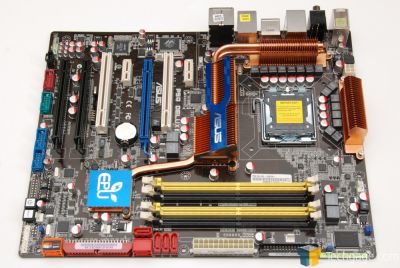
|
During a company-sponsored media event earlier this month, Gigabyte delivered a presentation in which it compared its own DES technology against EPU and also questioned the validity of some of the claims and performance figures Asustek has published. Asustek has reacted to this presentation by saying that Gigabyte does not have a full understanding of its engineering design and methods and so the accusations made were false.
Source: DigiTimes
Hypersonic’s Avenger AG2 Now Available
We posted a review of Hypersonic’s brand-new 12-inch notebook two weeks ago, and were impressed overall. It’s not the best-looking machine on the planet, but the pricing was right, and so was the performance (understatement). Well, the machine has now launched, and is available with many different configuration options.
Stock pricing a little bit higher than I originally anticipated, and the website itself seems a little confused as it quotes the “stock” price at two different values, but once entering the configurator, it’s at $1,359. That configuration includes a 2.1GHz T8100 Core 2 Duo, 2GB of RAM, 250GB hard drive and other usual goodies. There are two reasons the pricing is higher than expected. First is that the 1.66GHz CPU we expected didn’t make it in there, and also the default hard drive is much larger than what we thought it would be on the stock machine.
What is pretty much identical, though, is our “as-tested” machine. We were quoted the machine at around $1,599, and after we set the same options, the machine comes out at $1,598. However, that’s with 4GB of RAM and a 32-Bit OS, so it will cost an additional $20 to allow yourself to actually use all 4GB.
If you are looking for a notebook that’s comes in a smaller package but packs a wallop, check out their site and our review for all the details.
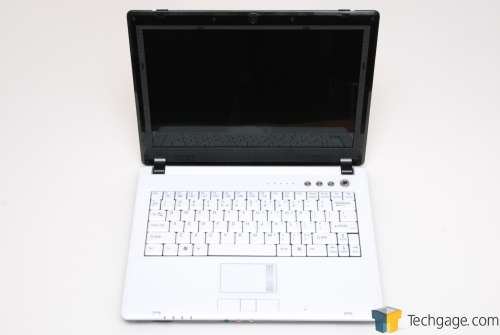
|
While other sub-notebooks, such as the Lenovo X300 or the Apple MacBook AIR build for better battery life, Hypersonic packs a powerful Penryn processor along with lots of RAM and a large hard drive. That’s the trade off, though. Better battery life or a faster machine? There’s no such thing as both unless you have a battery the size of the notebook itself.
Source: Hypersonic Avenger AG2 Review
Entertainment Software Association: Abandon Ship!
Following suit after Activision, Vivendi and LucasArts have all recently removed themselves from association with the ESA, id Software has left the organization which represents the interests of US video game publishers.
There are plenty of rumours but little facts about the real reasons behind these departures, but I’m sure we’ll see more companies following suit shortly. Perhaps it has something to do with the demise of E3.
Source: Game Politics
Dungeon Runners: The Box
Dungeon Runners, the post-apocalyptic survival MMORPG will be hitting store shelves at some point in the future, probably this summer.

Why buy a box for a game that is free? Well your $20 will buy you some bonuses:
- 6 Months of Membership Access, and all the perks that come with it, which would normally cost $5/month. The marketing geniuses at NCsoft think that’s a pretty sweet deal, one of them recently learned how to count. No Credit Card Required!
- Yes, you can buy 2 and get a full year’s membership for $40. You can also buy 3 and give one to your friend, or keep the third one and get 18 months for the price of 12. Really it’s nobody’s business what you decide to do with your boxes. Heck, buy 4!
- Access the new Bling Gnome sidekicks, that help you collect loot and, ahem, ‘process’ your gold. Available only with the boxed version of Dungeon Runners.
- …oh yea and Exteel is in there too.
So watch your store shelves for this, even if it’s just to add to your collection.
NVIDIA’s GDDR5 Stance Differs from AMD’s
I posted yesterday about AMD’s decision to use GDDR5 chips with their upcoming Radeon 4000-series, and from what it seems, NVIDIA doesn’t share the same ambition that they do. At the Nanotech: The Circuits Blog… blog, a quote from NVIDIA doesn’t discredit GDDR5 at all, but they note there isn’t a need for it right now.
Barry Wagner says, “We aren’t particularly attached to any given interface technology“, although both their current generation and next-generation (GTX 200) both use GDDR3. He goes on to note that they’d adopt it if it made sense for their business, which at this point doesn’t seem to be the case.
The true benefits of GDDR5 might not be seen with gaming, at least until incredibly memory-intensive games come out, but AMD’s keen to improve upon stream processing and parallel calculations (along with NVIDIA), and they feel the improved bandwidth of GDDR5 would be beneficial there. The same goes for DDR3 in the desktop market, but for those who own such memory, they likely know just how specific an application needs to be to fully exploit it, and nothing will be different on the GPU.
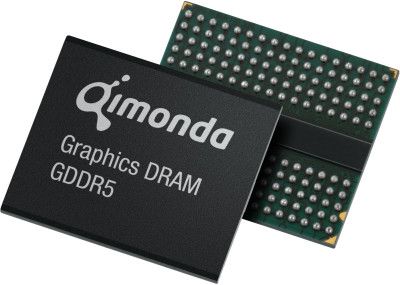
|
Nvidia is supporting the technology but taking a more cautious approach. The Santa Clara, Calif.-based graphics chipmaker holds a vice chair position in the GDDR5 task group, said Barry Wagner, director of technical marketing at Nvidia. “We’re involved in the specification of GDDR5 so if we want to build products around it, at least the spec is architected in a way that we would be content with,” Wagner said.
Source: Nanotech: The Circuits Blog
Top 10 Firefox 3 Features
With Firefox 3 right around the corner, have you thought about upgrading now? I personally have, but for some reason, the latest version looks incredibly ugly under my Gentoo Linux, on top of having ugly fonts… so I’ve stayed away. On my laptop, though, the latest beta works rather well, so it may very well depend on your distro, which shouldn’t (hopefully) be an issue at launch.
But that aside, Lifehacker loves Firefox 3 and gives us ten good reasons as to why. Their number one feature is a little surprising, as it’s not really a feature, but rather a performance increase. The sad thing is that 2.0 was so inefficient, it’s hard to not agree with them. Other new favorites include a revamped add-on manager, smarter location bar, native looks for each OS (which I’ve not seen apparently) and a streamlined “remember password” feature.
I admit that I’m still not blown away by FF 3, and at this point, I’m really unsure whether I will upgrade when the final stable version is launched. I personally haven’t seen huge performance increases, nor have I found the new features entirely useful, but I admit I haven’t given them that much of a chance. Another reason might be the fact that FF 3 seems to be the last of their priorities anyway, so I guess it should be somewhat expected. Hopefully my beefs are just that… mine only.

|
Your browser is a serious part of your computer time, so having it look like nothing else on your system can be seriously annoying. Firefox’s designers made system integration a priority with this release, and it shows-even Windows XP’s and Vista’s button layouts have subtle differences in color and shading. There’s differences at deeper levels, too, with Cover Flow-type styling in the add-ons manager for OS X, transparencies in key places in Vista and OS X, and other tweaks that make your browser feel like a natural extension of your system.
Source: Lifehacker
Will Microsoft Become ‘Directionless’ After Bill Gates Steps Outside?
With Microsoft’s chairman set to “retire” next month, people are wondering what’s going to happen within the company, and what direction, if any, they will go. There’s little debate that Bill Gates has been the lead driving force for the company, and one of the reasons Microsoft has proven so successful has been due to his keen focus and intellect, so who can replace him?
As a little self-debate at C|Net shows, there’s not supposed to be a “replacement”, in a real sense of the word, because the fact is, Gates is irreplaceable as a person. But the worry is still there. Will Microsoft be directionless without Gates at the helm, or will they continue to conquer the market for the next ten years, as they have for the last fifteen or twenty?
Some might argue that Microsoft is directionless now, but I believe part of that is incorrect, since they obviously conquer various markets. They might not be overly successful in the online/search market, but it’s their software that’s their bread and butter. Vista sure didn’t help matters much, but if “7” shapes up to become what Vista should have been, then people may take back the “directionless” comment.
Regardless of my or your opinions though, it’s going to be a very interesting next few months at Redmond.

|
No one can replace Gates–that is not the point. Microsoft is in several businesses and generates more than $50 billion in revenue and a very healthy profit. The company is fighting battles on a lot of fronts, especially with Google, which could generate nearly half the revenue Microsoft does just selling search ads. That’s not something Gates has been able to fix during the last few years.
Source: Outside the Lines Blog
NCsoft Covers New Ground in City of Heroes
NCsoft announced the release of City of Heroes® “Issue 12: Midnight Hour.†The newest free expansion for current subscribers, Issue 12 brings to life a special covert group from the game’s lore, highly-anticipated Villain Epic Archetypes, more powerset options and character slots for players, plus a whole new Greek- and Roman-inspired zone to explore!
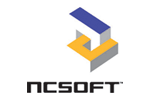
City of Heroes Issue 12 brings the Midnight Squad out of the lore and into the game. The Midnight Squad is the clandestine organization of mystics, scholars and mages who hold a secret that could bring the alien group, the Rikti, to its knees. Players are encouraged to help the Midnight Squad uncover the secret that could help save Paragon Cityâ„¢ and the Rogue Isles from further alien assaults.
Issue 12 also introduces Powerset Proliferation, which vastly increases the variety of villain and hero characters that players can create. Some powersets, previously only available to hero archetypes, are now available to designated villain archetypes, and vice versa. To help accommodate all of these new character options, the development team has opened additional character slots. All current subscribers receive two new character slots for use on the server of their choice. Other slots may be acquired as a part of the Veteran Rewards program, or for purchase. Details can be found on the City of Heroes web site.
Qimonda Bringing GDDR5 to ATI’s Radeon 4000-series
AMD has decided to lead the pack where GPU memory is concerned, and Qimonda is the company to deliver. The Radeon 4000 series, which will launch next month, will be the first to feature GDDR5, an evolutionary upgrade to GDDR4, which will feature faster speeds, improved bandwidth and more efficient power features.
Launch GDDR5 parts will be offered in speeds from 900MHz (3.6Gb/s) up to 1GHz (4.0Gb/s) and will run on 1.5v, compared to the 1.8v for GDDR4. Launch cards will not use memory speeds beyond 4.0Gb/s on the 16M x 32 arrangement, however, as the faster and higher-density chips will not be available to Q3 and Q4 (which go up to 5Gb/s).
Both the speed increases and feature-additions are what makes any new DRAM type worthwhile, and GDDR5 does have a few tricks up its sleeves. New is an error detection mechanism, which is similar to ECC server memory. It calculates an eight-bit CRC algorithm on each data burst and instantly allows a calculation repeat on a detected error, improving efficiency.
Then we have clamshell mode, which enables a 32 I/O to be reduced to 16 I/O, allowing each DQ to connect to a separate IC in x16 mode. This feature is a little confusing, as it makes no difference in bandwidth, so the question is, what’s the purpose? I’ll be checking with Qimonda to see if they have an answer up their sleeves.

|
Munich, May 21, 2008 – Qimonda AG, a leading manufacturer of memory products, today announced that the company has won AMD as launch partner for the new graphics standard GDDR5. Qimonda already started mass production and the volume shipping of GDDR5 512Mbit components with a speed of 4.0Gbps to AMD, a leading global provider of innovative processing solutions in the computing, graphics and consumer electronics markets.
Source: Qimonda
NVIDIA’s GTX 200-series Specs Revealed
While NVIDIA’s 9-series launch seemed a bit lackluster, given that they were primarily an over-glorified 8-series (though I can’t say enough good about the 9600 GT), the companies’ upcoming GTX 200 cards are looking to wipe the disgruntled looks off all our faces.
According to DailyTech, two cards will launch initially, the GTX 260 and GTX 280. As you’d expect, the GTX 280 is the highest offering, which will include 240 stream processors (compared to 128 on the 9800 GTX), a huge 512-bit memory bus width, support for up to 1 GB (although it should be possible for companies to add more). On top of those, the unified shaders are to perform 50% faster than previous generation cards.
The lower-spec’d GTX 260 removes 48 stream processors, for 192 total, decreases the memory bus to 448-bit and also lowers the memory to 896MB. Despite the decreases, it’s hard to assume that this card will be “gimped” by any standard. Going by specs alone, even the GTX 260 should be absolutely stellar.
The downside, if there is one, is that DX10.1 will not be supported. This is a bit striking, but goes to show NVIDIA doesn’t have much faith in it, or feels the need for inclusion. It would have been nice to see it added either way though. Embargo is set to lift on June 18th, which is right around the same time that ATI will lift theirs for the Radeon 4000-series.
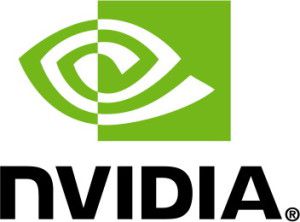
|
The GTX 280 enables all features of the D10U processor; the GTX 260 version will consist of a significantly cut-down version of the same GPU. The D10U-30 will enable all 240 unified stream processors designed into the processor. NVIDIA documentation claims these second-generation unified shaders perform 50 percent better than the shaders found on the D9 cards released earlier this year.
Source: DailyTech
Intel to Launch Q9650 in Q3 to Replace QX9650
According to Chinese hardware site HKEPC, Intel will be discontinuing the current high-end QX9650 Extreme processor in Q3, with an identically-specced mid-range offering, appropriately named, Q9650. The new CPU will be identical all-around to the QX9650, including the 3.0GHz clock speed, 12MB cache and 1333MHz FSB, but will retail for $530USD… half of the current Extreme processor.
Also noted is that the E8600 will show face around the same time, but we knew that already. It’s a Dual-Core offering at 3.33GHz and will retail for $224. In addition to these launches, the Q9550 is to decrease to $316, while the Q9400 will see a new $266 price tag. Probably not-so-surprisingly, the Q9300 and Q6700 will fade out at this time.
The interesting thing is that while the QX9650 will essentially become the Q9650, there will be no “high-end” offering available, except for the ultra-high-end QX9770, which currently retails for around $1,500. I don’t think many in their right mind would pay a $1,000 premium at that time for a 200MHz boost, so we have to wonder if Intel has something else up their sleeve. But given that Nehalem will be right around the corner at that time, the next Extreme edition we see may very well be one based on the new architecture.
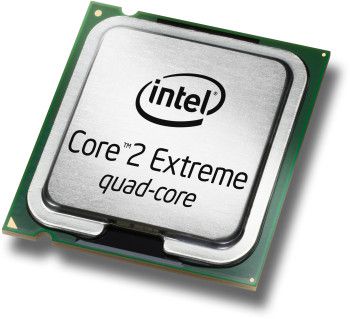
|
Core 2 Quad when Q9650 core the arteries are 3GHz, supports 1333MHz FSB, to construct 12MB L2 Cache (6MB x 2), highest TDP is 95W. Will lie in the frequency multiplication with the Core 2 Extreme QX9650 distinction to lock, has limited its ultra frequency ability. The selling price aspect, Core 2 Quad Q9650 every thousand unit prices are $530 US dollars, compares Core 2 Quad QX9650 every thousand unit prices to reach as high as $999 US dollars amiable.
Source: HKEPC (Translated to English)
Jack Thompson: guilty on 27 charges
Jack Thompson, the thorn in the gaming industry’s side, was found guilty of between 27 and 31 charges yesterday. The Judge’s recommended guilty verdicts include, “knowingly making a false statement of material fact or law to a tribunal,” “using means that have no purpose other than to embarrass, delay, or burden a third person,” “engaging in conduct involving dishonesty, fraud, deceit, or misrepresentation,” and “making statements that the lawyer knows to be false or with reckless disregard as to the truth or falsity concerning to the qualifications or integrity of a judge.”
And that’s not even taking into account that he used gay porn in his court filings, and a picture book of swastikas, squirrels and fingerpaintings in his defense.
In his closing statement he quoted from the bible that “it would be better that a millstone be tied around your neck and that you be cast in the uttermost depths of the sea.” Dude you’re the one who’s gone overboard.
Justice has begun to be served.
Source: Ars Technica
Gateway’s XHD3000 Now Works Under Linux (Somehow)
When I reviewed Gateway’s XHD3000 a few months ago, I complained that Linux would not work with it at the native resolution. To me, that was a big problem, since I occasionally benchmark under Linux on our test rigs. Other than that though, the monitor was fantastic.
Well, sometime between then and now, the problem fixed. For fun, I hooked up the XHD3000 to my main machine, just to play around with dual-display possibilities, but in doing so, I expected the NVIDIA driver to default to 1280×800… the same resolution I’ve always been stuck to. I was quite surprised when I saw the native resolution of 2560×1600 become available, though, and applying it delivered the promised result.
I also tested the monitor by itself afterwards to make sure that it wasn’t only enabled because I had it as a secondary display, and it again worked just fine. So we might very-well be at a point where all 30-inch displays should work under Linux with little issue, and from what I can tell, we might have NVIDIA to thank. For those interested in the monitor in question, you can click to read the review below. I liked it enough to buy one, which may very well speak for itself.

|
Gateway, not content to let Dell and others hog the limelight in the display market, have recently launched their XHD3000 monitor. It offers a wide-range of connectivity options along with bright picture and an incredible upscaler. When said and done, this is one model we can heartily recommend.
Source: Gateway XHD3000 Review
Valve Updates Steam Hardware Survey
It’s time again to peruse the results of the latest hardware survey on Steam. There are a few interesting and not-so-interesting results this time around. First up is network speed, which shows less than 5% are still on dial-up, while another 30% are on a 1Mbit or lower. The most popular network connection is 2Mbit, at 31%.
For RAM, an 38% are using 2GB and higher. The bulk of the CPU usage belongs to Intel with 58.48%, with AMD not so far behind with 41.51%. Interestingly, there are 109 Tri-Core Phenom users mixed in there, with three users running 127 cores. Is that even reasonably possible?
The majority of users are using NVIDIA’s 8800 series, which could include pretty-well any of the models, which is unfortunate, since an 8800GS is far different in performance than the 8800GTS 512. NVIDIA dominates though, with ATI’s classic cards being the most popular. The top ATI card is actually the 9600. Believe that!?
Here’s another interesting stat, and one I’m having a seriously hard time believing. Where 16:9 displays are concerned, 15% are using a 24″ offering, while a staggering 19.32% are using larger than that. The majority of users, however, use 1280×960, at 40% of all submissions. This makes no sense to me.
It’s not at all surprising to see Windows XP in the lead for OS choice, with 81%, with Vista 32-bit at 15% and 64-bit at 2.65%. Check out the link below for the rest of the results, and just drop your jaw in the fact that some people are running less than 256MB of RAM and others run displays less than 7″ in size. Nuts!
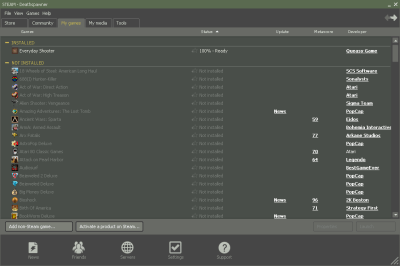
|
Every few months we run a hardware survey on Steam. If you participate, the survey collects data about what kinds of computer hardware and system software you’re using, and the results get sent to Steam. The survey is incredibly helpful for us as game developers in that it ensures that we’re making good decisions about what kinds of technology investments to make, and also gives people a way to compare their own current hardware setup to that of the community as a whole.
Source: Steam Powered Survey Results
Adobe Releases Flash 10 Plugin Beta
The latest version of Adobe’s Flash is coming soon, but for those antsy, there is a public beta now available. “Public” might be the wrong word, since it’s designed for developers, but there will no doubt be far more public testers than developers. The latest version brings advanced 3D features, paving the way for better 3D gaming via a web browser, with a small sample available on their site.
Also new is the ability to create portable filters and blend modes, advance text layout with the help of a new engine as well as overall performance increases for current Flash-based applications/videos. This is done by pushing most of the processing power to the GPU, rather than the CPU.
Surprisingly, Adobe made the beta available to Windows, Mac OS X and Linux all at the same time. This is impressive for Linux, since it took forever to see a Flash 9 plugin. However not-so-surprisingly, the new plugin will not work on a 64-bit Linux (neither does 9, natively), so that counts me out! For now, at least.

|
This public prerelease is an opportunity for developers and consumers to test and provide early feedback to Adobe on new features, enhancements, and compatibility with previously authored content. Once you’ve installed Flash Player 10 beta, you can view interactive demos. You can also help make Flash Player better by visiting all of your favorite sites, making sure they work the same or better than with the current player.
Source: Adobe Labs
Investor Carl Icahn Pushes Forward with a Yahoo! Proxy Battle
You might have thought that the entire Microhoo! deal was long over, but that might not be the case. Microsoft withdrew their bid two weekends ago, but we found out only a day later that Yahoo! would be up for more negotiation. What that proved to us was that Yahoo! only had intentions to drive their sales price up, and didn’t really think they were worth the quoted $37 per share.
Here’s where things might get interesting. Billionaire investor Carl Icahn has decided to press forward with a proxy fight with the goal to remove Yahoo!’s current board and replace them with people who have some business sense. This wouldn’t affect just half the board, but all 10 members.
Of course the question now arises, would Microsoft even be interested in resuming talks? Microsoft CEO Steve Ballmer seemed rather disinterested in Yahoo! after the needless two-and-a-half month barter-fest. Could he have had enough, and would Yahoo! be interested in pitching a more reasonable offer? We may know as soon as tonight.

|
Any Yahoo shareholder faces a Thursday deadline for nominating an alternate slate of directors, which could then conceivably press for the company to return to merger negotiations with Microsoft. Those nominees could be elected at the Yahoo’s annual meeting slated for July 3.
Source: MarketWatch
Dell’s XPS Line-up Isn’t Going Anywhere
We posted the other day about a Wall Street Journal article that claimed Dell was pulling their XPS gaming line-up in order to focus primarily on Alienware. As it was quoted, the XPS line was “cutting into” Alienware’s profits… which did seem like an odd claim to make.
It turns out that even well-respected newspapers can be completely and sorely wrong. Dell representative Anne Camden posted on the official blog that XPS wasn’t going anywhere, and that the WSJ was incorrect. Rather, Dell will be investing “like crazy” into Alienware, making sure that it will become the premier game PC builder out there, but the XPS line-up will live on.
Anne goes on to state that the XPS line-up is an integral part of Dell’s heritage, and recent product launches contradict a company that suddenly that would want to pull the plug on a series. So there you have it, XPS is here to stay, and I for one am pleased. I’ll always build my own rigs (no surprise there), but if I was suddenly lazy, the XPS line-up would be one I’d consider. The last few iterations of their rigs have been amazing.

|
Dell XPS and Alienware are both great brands – arguably the greatest brands in PC gaming – and both will live on. But we are going to expand our focus on Alienware. We are going to invest like crazy in product development, design and engineering to propel Alienware as the premier gaming brand in the future.
Source: Dell Blog
Splashtop on up to 1 Million ASUS Motherboards Per Month
In case you happened to miss it yesterday, I posted a brief article taking a look at the latest iteration of DeviceVM’s Splashtop, as seen on ASUS’ upcoming P5Q Deluxe. Numerous sites posted about this yesterday, but not a single one posted much info in any real depth, nor a single screenshot. We did, and I recommend checking it out to learn more about this cool technology.
The huge news was the fact that ASUS is heavily backing the technology, with a goal to include the embedded Linux environment on up to 1,000,000 motherboards a month. You read that right, one million. That means if you buy an ASUS motherboard in the months to come, chances are good it will come pre-installed with Splashtop.
One thing that many tend to misunderstand is that Splashtop is not supposed to replace your primary OS. It can’t even save to a regular hard drive, or even allow you much customization at all. What it is for is quick bouts for specific reasons. The quick boot time can help you get things done fast, and as we’ll see in the months to come, it will certainly have a place in the notebook market. The best part is that you don’t even need to know Linux to use it.
I will be talking to both DeviceVM and ASUS about this and more at Computex, which occurs in a few weeks. So stay tuned.

|
Dubbed “Express Gate” by ASUS, Splashtop is a heavily-modified Linux environment that’s built into a flash chip on a motherboard, allowing you quick access to its features. After pushing the power on your tower, you can be inside the environment in just under ten seconds, ready to take advantage of whatever applications are pre-installed.
Source: ASUS Shows Faith in Splashtop





